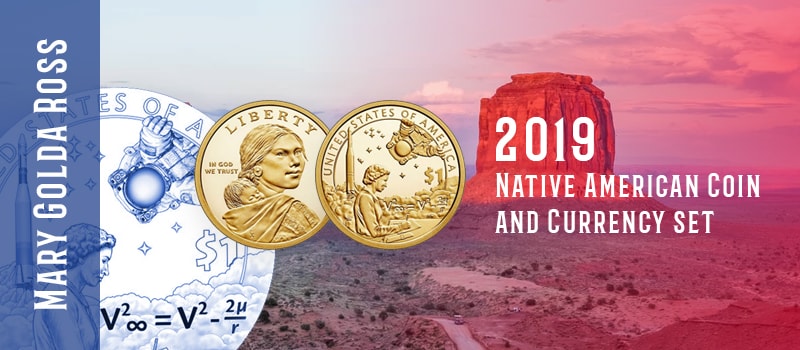2019 Native American Coin and Currency set

The U.S. Mint honors Native Americans through the Native American dollar released every year since 2009. The obverse of the coin showcases the ‘Sacagawea’ design that was originally used in the 2000 design of the Sacagawea Golden dollar featuring a portrait of her carrying her infant son, Jean-Baptiste. This year the mint has released a coin and currency set that features the contribution of Native Americans to the U.S. Space program.
Check out the 2019 Native American Coin and Currency set
Native American contributions to the U.S.A and the World
Native Americans who are said to have migrated through the Beringia – a land bridge from Asia to the Americas have contributed a lot to the world. From the common rubber balls and balloons to aqueducts that connected various water sources for irrigation, canoes and dams, the Native Americans had discovered things that Europeans thought of a good 1000 years later.
The Olmec and Mayans were amazing mathematicians who discovered zero independently from the Indian Hindu zero discovery. They developed complex arithmetic functions that helped them make sense of astronomy, architecture, seasons and the universe. The Andean and Mesoamerican people built towers to study the movement of planets and stars and other events and made accurate observations.
During the Second World war, 400 to 500 Native American men became code talkers sending tactical secret messages across enemy lines using substitution cipher created with their native language.
Mary Golda Ross – The First Native American Engineer
Mary Golda Ross was the grand daughter of the Cherokee Chief John Ross, who had Scottish-Cherokee mixed ancestry. He was a man of great standing in both the Native American and European political circles. Mary stayed with her grandparents in the Cherokee capital of Tahlequah and did her primary and secondary education.
Mary G. Ross was a brilliant student and wanted to study Science and Mathematics. It was the roaring 20’s and an exciting time for American women. It helped women like Mary as it was probably one of the best times for women wanting to study and get careers. Women could finally vote and get college degrees. During the First World War many women came out of their homes to work in factories in place of the men who left for war. After the war, they didn’t really want to go back to the cloistered existence in their homes. Many women took advantage of the increasing opportunities and came up in different fields.
Mary Golda Ross earned a bachelor’s degree in Mathematics and then went on to get her Master’s in Colorado State Teacher’s College. For the next decade Mary taught Mathematics and Science in rural Oklahoma schools. At the age of 34, she was hired as a mathematician by Lockheed, an aerospace company in California. She worked on the effects of pressure on the P-38 Lightning; one of the fastest airplanes at the time. She was then sent by Lockheed to UCLA to get professional certification in Engineering. At 44, she joined Lockheed’s Advanced Development Program at the Skunk Works where she worked on concepts for interplanetary space travel. She worked on the Agena rocket project and on design concepts for flyby missions to Venus and Mars.
Mary Golda Ross’s later life was dedicated to recruiting young women and Native Americans into the field of Engineering. She supported American Indians in Science and Engineering Society (AISES).
2019 Native American Coin and Currency set
The 2019 Native American $1 Coin reverse design honors the contributions of Native Americans to the U.S. Space Program. Native American contributions to the U.S. Space Program culminated in the three spacewalks of John Herrington (Chickasaw) on the International Space Station in 2002. These and other pioneering achievements date back to the work of Mary Golda Ross.
The reverse design depicts Mary Golda Ross writing calculations. The formula is an example Mary G. Ross could have used to calculate interplanetary space travel, determine the departure plane orbit, and transfer orbit energy. Behind her, an Atlas-Agena rocket launches into space, with an equation inscribed in its cloud. An astronaut, symbolic of Native American astronauts—including Herrington—spacewalks above. In the field behind, a group of stars indicates outer space.
Reverse inscriptions are “UNITED STATES OF AMERICA” and “$1.” The 2019 Native American $1 Coin has a special enhanced uncirculated finish and was minted at the Philadelphia Mint.
The $1 Series 2017 note is from one of the 12 Federal Reserve Bank locations across the U.S. and features a serial number beginning with “1959”. The year corresponds to the launch year of the Agena spacecraft depicted on reverse of the coin.
This entry was posted in General, U.S. Coins and tagged us coins on August 21, 2019 by lavanya kannan

Leave a comment